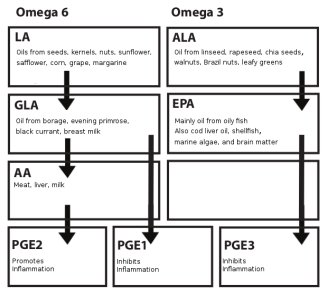Omega-3 fatty acids help relieve rheumatic pain but only if you get enough
 British scientists have tested whether omega-3 fatty acids from fish oil supplements have a pain-relieving effect on patients with rheumatoid arthritis. As it turns out, consuming fish oils with large quantities of EPA and DHA has the best effect, so make sure to read the label to see how much of the two omega-3 fatty acids your supplement contains. Rheumatoid arthritis and other rheumatic diseases are a result of joint inflammation, so it may also pay off to look into the benefits of an anti-inflammatory diet.
British scientists have tested whether omega-3 fatty acids from fish oil supplements have a pain-relieving effect on patients with rheumatoid arthritis. As it turns out, consuming fish oils with large quantities of EPA and DHA has the best effect, so make sure to read the label to see how much of the two omega-3 fatty acids your supplement contains. Rheumatoid arthritis and other rheumatic diseases are a result of joint inflammation, so it may also pay off to look into the benefits of an anti-inflammatory diet.
Rheumatoid arthritis and other types of arthritis are common. A large number of people with these conditions take anti-inflammatory drugs that may cause side effects and increase your risk of premature death. It is far better to look into natural solutions for treating rheumatic pain. British scientists have tested the two omega-3 fatty acids, EPA (eicosapentaenoic acid) and DHA (docosahexaenoic acid), that are found in fish oils and cod liver oil. The researchers analyzed 18 placebo-controlled studies of omega-3 and rheumatoid arthritis. Their systematic review included a total of 1,143 people who consumed 2.1 – 9.1 grams of fish oil daily (the equivalent of two to nine large fish oil capsules). The studies lasted between 12 and 52 weeks. Ten of the studies supported the hypothesis that consuming omega-3 fatty acids has a pain-relieving effect. The conclusion, which was based either on the subjective feeling of the patients or a medical assessment, showed that omega-3 fatty acids help as pain-relieving therapy in patients with rheumatoid arthritis. The best effect was observed with daily intake of 3-6 grams of fish oil.
The study was published in the science journal Nutrition in 2017.
Other studies suggest that it is EPA in particular that counteracts inflammation, so it is a good idea to study the label and make sure to get 900-1.800 mg of EPA on a daily basis.
It takes around a month for the fish oil supplement to work optimally. Similarly, if you discontinue your fish oil therapy, it takes about a month before the effect wears off.
Too little omega-3 and too much omega-6 sets the stage for rheumatism and inflammation
The essential omega-3 and omega-6 fatty acids control inflammatory processes in the body. Normally, the body must be able to initiate an inflammatory process in the case of an infection. However, it is vital that this process must be controlled in order not to result in a chronic inflammation. We get most of our omega-3 from oily fish, while vegetable oils are our main source of omega-6. After consuming these fatty acids, the body converts them into some hormone-like compounds called prostaglandins (PG1, PG2, and PG3) that all have different biochemical effects in the body. In situations where we consume too much omega-6 at the expense of omega-3, chronic inflammation may occur, and this can set the stage for rheumatoid arthritis and other inflammatory conditions that are often linked to our modern lifestyle and dietary habits.
The Nobel Prize, diets, and inflammation
In 1982, Sune K. Bergström, Bengt I. Samuelson, and John R. Vane, three biochemists, were awarded the Nobel Prize for their research in different prostaglandins and the way these affect our health. The following overview of fatty acids and prostaglandins is highly simplified yet provides a rather useful understanding of why our diet is so important for treating rheumatic diseases and controlling inflammation.
 |
What kind of diet promotes inflammation?
Today, farmed fish, slaughter animals, chickens, and dairy cows are fed a diet with a high omega-6 content. This is strictly bottom-line thinking. As a result of this diet, fish, meat, eggs, and dairy products contain less omega-3 than they used to. The wrong animal feed, reduced consumption of fish, and increased consumption of ready meals and margarine are the reason why many of us consume far too much omega-6 and too little omega-3. The typical Western diet contains omega-6 and omega-3 in a 10:1 ratio (in some cases it may even be a 30:1 ratio). Scientists consider a 4:1 ratio (or less) to be ideal.
The body converts fatty acids into various prostaglandins by means of different enzymatic processes that also require the presence of vitamins and minerals. Unfortunately, many people are deficient in vitamin D, selenium, zinc, and magnesium because of factors such as too little sun exposure, nutrient-depleted soil, unhealthy diets, and stress. Modern diets also make us overweight, and visceral fat (belly fat) is especially dangerous, as it increases the risk of inflammation.
Most people can easily utilize omega-3 fatty acids from fish oilLinseed oil and certain other vegetable oils contain omega-3 fatty acids in the form of ALA (alpha-linolenic acid). However, many individuals lack the enzymes needed to convert ALA into EPA. Since the Stone Age, our main source of omega-3 (EPA) has been oily fish. EPA is easily converted into anti-inflammatory type 3 prostaglandins. |
References
Abdulrazaq, Innes JK, Calder PC. Effect of ω-3 polyunsaturated fatty acids on arthritic pain: A systematic review. Nutrition 2017
https://www.ncbi.nlm.nih.gov/pubmed/28606571
http://www.zonediet.com/blog/what-are-the-real-differences-between-epa-and-dha/
https://www.ncbi.nlm.nih.gov/pubmed/16531187
https://www.nobelprize.org/nobel_prizes/medicine/laureates/1982/
Pernille Lund. Immunforsvarets nye ABC. Hovedland 2012
Search for more information...
- Created on .








